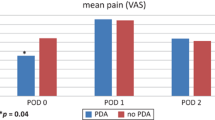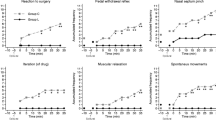Abstract
The laboratory piglet is currently the preferred animal for experimental digestive surgery. In order to ensure optimal perioperative analgesic control with motor blockade during surgery together with rapid postoperative recovery, epidural anesthesia techniques were developed in this animal. We report the anatomo-radiologic studies (10 animals) and clinical experiments (51 transplantations of the liver and the small intestine) which led to the refinement of this anesthesia. In laboratory piglets, epidural anesthesia by distal transsacral (S4-S5) or sacrococcygeal approach is possible in a reproducible manner. The localization of the injection site is simple and epidural space catheterisation is easy without risk for the dural sac which ends at S1-S2.
Similar content being viewed by others
Author information
Authors and Affiliations
Rights and permissions
About this article
Cite this article
Richer, J.P., Lacoste, L., Faure, J.P. et al. Sacrococcygeal and transsacral epidural anesthesia in the laboratory pig:a model for experimental surgery. Surg Radiol Anat 20, 431–435 (1999). https://doi.org/10.1007/s00276-998-0431-5
Received:
Accepted:
Issue Date:
DOI: https://doi.org/10.1007/s00276-998-0431-5




